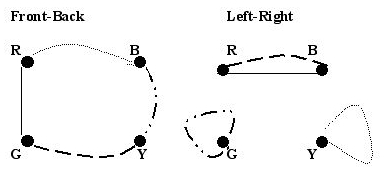3(24)3
The colors on the opposite side
You have a stack of blocks with the following alignment of colors:

Draw two graphs, one for each of the front-back and left-right pairs. For each, the vertices are given labeled by colors. On the front-back graph, draw an edge between two colors if one of the blocks has those colors on the front and back faces. Label edges by the number of the block the pair is from. Draw a similar graph for the left-right pairs.

What do you notice about the graphs? What similarities do they have? Are the similarities enough to guarantee that the stack will work? Why or why not?
Both graphs have one edge per cube and two edges per color(vertex).
This will guarantee that the stack will work, since we can follow the edges around and make the first vertex of each edge the front and the second the back (or left and right respectively) so that each side of the stack has all different colors.
So how can we use what we learned to FIND a solution?
Above we noted that it is opposite pairs of faces that matter!
We also noted that if we draw edges on a graph for these pairs, we need to find two subgraphs where:
- each color in the subgraph has degree two
- there is an edge in each subgraph from each cube
- the two subgraphs use a total of eight different edges.
Try drawing a graph for the set of blocks that you have! For convenience, there are spaces on the paper to put the blocks so you remember which is which.
Example:

Now you can put the cubes together to win!
